- Bernard Preston homepage
- Bread
- Real and Fake Bread
Real and fake bread
Real and fake bread considers why consumption has dropped dramatically in the last 70 years; by more than 50pc in much of the world.
This trend predates the so-called keto diets and even the McGovern guidelines issued in the United States in 1977; those encouraged Americans to eat much less saturated fat and more carbohydrate including bread.
This is one of the most important columns at this site. Pour a cup of tea and take your time; it's absolutely central to greater wellness. It is a twenty-minute read.
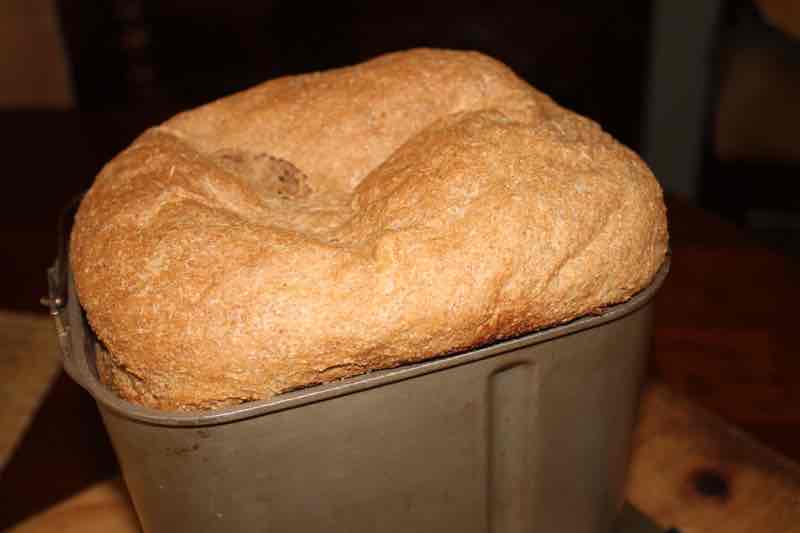 Slow-bread baked after a long ferment.
Slow-bread baked after a long ferment.Clearly many people have abandoned bread in favour of other starches. The subject is highly complex and controversial. What cannot be denied is that folk simply don't like the commercial-loaf any more; neither the bland taste nor what it does to their innards and waistlines.
Gastric disturbances ranging from diarrhoea to bloating and frank pain have become the norm for many since baking methods changed; the Chorleywood bread process.
And this despite the fact that the Chorleywood bread-process has dramatically lowered the cost of baking the loaf that we would typically find in a supermarket. This technology is almost certainly the cause of the abdominal pain so many now experience.
Real bread
There are typically two definitions of real bread.
- Bread which is baked using only 100pc flour, salt and water; dried yeast and perhaps a little added fat.
- Bread which is baked using "wholemeal" flour but with none of the additives used today; more about them lower down.
The first definition is the gold-standard which the diehards would defend with their lives. However since 100pc wholemeal flour is only really available to those with a small mill, it is unrealistic for the general-public; and so the second is the one commonly used. There is nevertheless a proviso.
There is a big fat-lie in the industry which enables millers to market their flour as "wholemeal" provided they have not removed more than 40% of the goodies; the germ and bran. That's where much of the special essential amino acids, vitamins and minerals are located.
The lignans that help prevent breast tumours have also been extracted; it comes thus as no surprise that mammary-gland neoplasms have surpassed those of the lung. Many folk have sensibly stopped smoking but simultaneously are eating less of the foods rich in this vital phytonutrient.
So your real bread by the second definition will not be a whole-grain as advised by the McGovern commission in 1977 but refined to an unknown and not displayed degree. You can be sure that all the wheatgerm oil and vitamin E have been extracted; and sold to farmers for animal feed.
We have been duped by big food companies and the cost is beyond measure; loss of the chief natural anti-coagulant in the blood and one of the most potent modulators of breast tumours. It boggles the mind.
I hope these issues of real and fake bread are beginning to stir you; it's not "small beer."
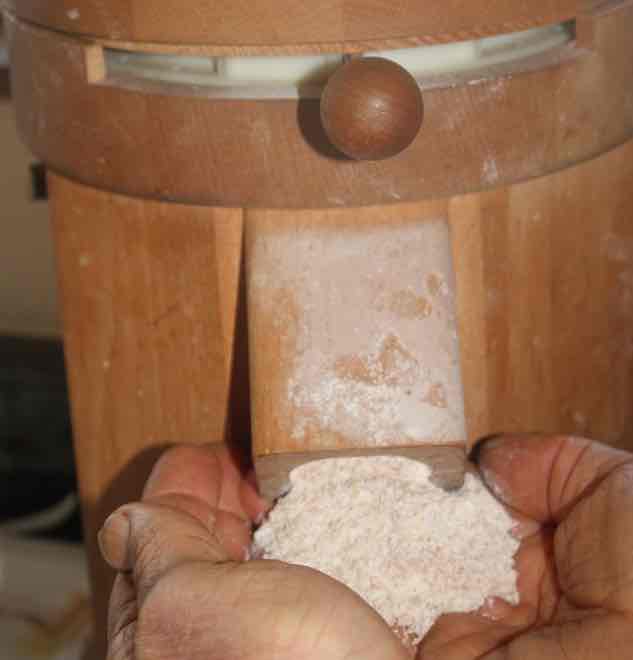
In a report to the Council on Foods and Nutrition, Dr Russell M. Wilder, MD writes as follows.
"Although the texture and colour of the refined white flour was a great improvement over the gray, coarse stone-ground meal, it contained much less of the bran and thus was deficient in vitamins and minerals."[4]
I find this quite odd when looking at our stone-ground meal; it's neither gray nor coarse. Perhaps modern mills are far better. As to whether the refined white flour is a great improvement or not, you must be the judge.
The McGovern committee
The McGovern Select Committee after wide consultation recommended that Americans eat far less cholesterol-rich foods and sugar; and instead turn to whole grains, fruit and vegetables.
Are you getting some ideas as to why whole grain is better?
In theory these were clearly good guidelines but there were serious unintended consequences. Fat in large measure provides the satiety that we all crave, that sense of fullness; Americans became constantly hungry after taking up those recommendations. And they simply couldn't reduce their sugar intake; today they on average consume nearly one cup every single day of the year[1].
And because whole grains were and are difficult to find, constantly famished they turned to snacking on refined carbohydrates and sugary-colas. Within a very short period of time Americans became obese and after twenty years levels of type 2 diabetes began to soar and with it the very cardiac disease that McGovern was trying to reduce.
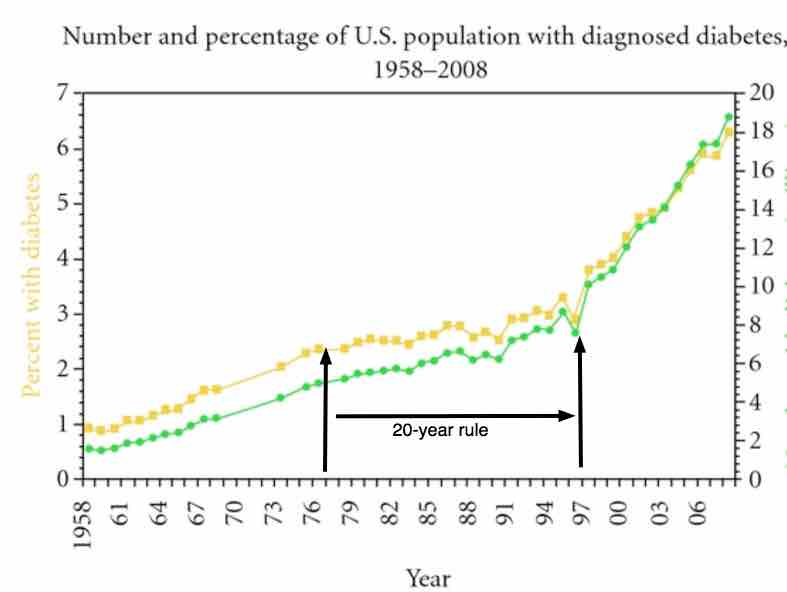
In South Africa our own researcher, Dr George Campbell faced with these findings after studying rural and city Zulus and Indians proposed his twenty year diabetes rule. Refined grains and sugar are killers.
"One-third of Medicare’s 62 million beneficiaries live with diabetes."
- Healthline
Fake bread
Fake bread is more difficult to define; there's a gradation of deceit in the baking-industry.
Firstly obviously increasingly refined flour no matter how much it is "enriched" the more fake it is, devoid of the nutrients our bodies crave. Calcium, iron and the B-vitamin family have been extracted.
The natural anti-coagulant, vitamin E, that is found with the oils has also been removed.
Is it not supremely ironical that in trying to reduce cardiovascular disease, the McGovern committee pushed us in the direction of fake bread from which all the vitamin E has been extracted? Cardiologist Wilfred Shute states that heart-attacks were almost unknown prior to the milling and refining of wheat.
And secondly fake bread is today baked using a whole bunch of additives that the food industry steadfastly refuses to divulge and list on the packaging.
Bread additives
For millennia bread was baked the slow way; until in fact about 150 years ago. Natural yeasts found in the bran, and fermenting bacteria, were given time to gently release carbon-dioxide and many other important acids and vitamins; they also gave the loaf its delicious sourdough flavour.
This fermentation also predigested the protein in the flour, the gluten, that otherwise would have caused havoc in the gut of some sensitive people.
Gluten has a very high proportion of an amino-acid called proline that is quite different to all its cousins; it resists digestion with very strong bonds to its nearest neighbours. The result is that without prior fermentation short fragmented chains of protein reach the intestine where they are viewed as the enemy and provoke a huge immune-response.
In its worst form it is known as Coeliac Disease; and interestingly was first identified only about 70-years ago, just when the bread industry started to mess about and use additives to speed up the process of baking.
Commercially slow-bread ceased to exist. Instead we are now offered a tasteless loaf that causes all sorts of tummy troubles and makes us fat; consumers have started voting with their feet. Despite the fact that bread is so cheap, they are purchasing far less; consumption has dropped dramatically.
In short the baking-industry has shot itself in the foot, and us too.
There are now dozens of these bread-additives that speed up the process of baking, make the crumb softer and preserve the loaf, even for weeks.
There are emulsifiers, preservatives and enzymes; bleach, reducing-agents and many others, making the commercial baker's life much easier. But it has left us with a loaf that is insipid, lacking in nutrition and toxic for the intestinal lining for some.
Are you beginning to grasp that there is a vital difference between real and fake bread? It would not be an exaggeration to state these are quite literally life and death issues. The protection given by the vitamin E against cardiovascular disease and the lignans that help keep breast-tumours at bay alone makes this central to our wellness.
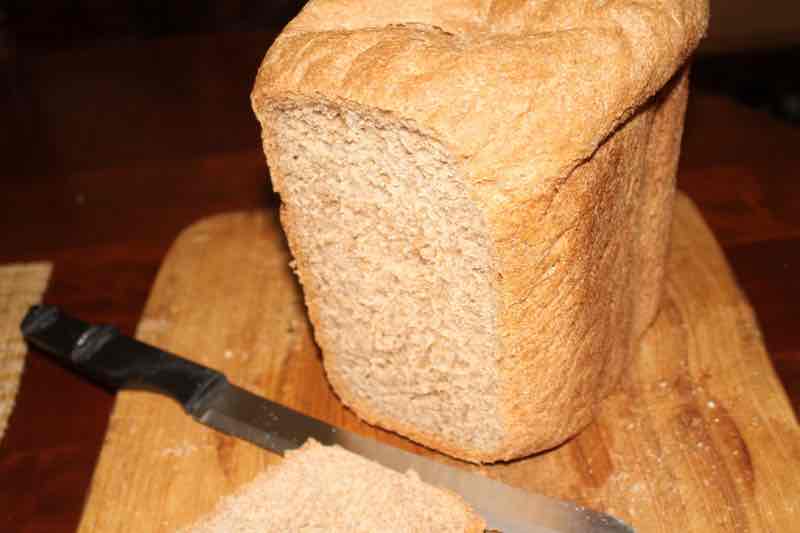 Sourdough loaf made with 100% flour.
Sourdough loaf made with 100% flour.Five types of bread
- 100% wholemeal bread
- "Wholewheat" bread of different degrees of refinement
- Brown bread
- White bread
- Cake bread, for example a banana loaf made with bleached-flour.
From top to bottom we move progressively further from real to fake bread. If made in a large commercial-bakery there will almost certainly be various additives used.
Sourdough
The sourdough loaf made the old-fashioned slow way using natural yeasts and various bacteria that ferment the flour is what we recommend; it clearly delineates the difference between real and fake bread.
A purist would not add yeast, but we do to give a lighter loaf; that's your decision. There is no right and wrong way.
The length of time is up to you; I do not have gluten issues so I ferment it only for about five-hours. You might want to leave it overnight, and only add any extra dried yeast in the morning.
If you suffer from Coeliac Disease then you would need to ferment the dough for at least 24-hours; and use some flours with less gluten.
The lactic and acetic acids give the bread the familiar sourdough taste. Just as important they lower the glycemic-index, the rate at which the sugars are released into the blood stream. This has huge implications for the obese and diabetics who absolutely should avoid all commercial loaves. The issues surrounding real and fake bread are not small beer.
We should keep the glycemic load down by having perhaps only half or one slice, and diabetics should test their blood-glucose to see what the response is. If you still have to shoot yourself with extra insulin then you should just give up all bread permanently.
- GI of commercial brown bread = 81[2] (high)
- GI of sourdough bread = 54[3] (low). Made with 100% flour it would be even less.
Sourdough bread recipe
There are many sourdough recipes and dozens of ways of doing it. We use a bread-machine. Including milling the flour, this takes me only five-minutes every morning when I have all the ingredients at hand; it is not a long and laborious business.
Making good bread is not rocket-science, nor is it difficult. Done by hand it would take about thirty-minutes but interspersed over a day or so.
The cost is under R10 (half a dollar) for the finest bread in the world; given the right amount of time, it will not give your tum the collywobbles.
The issues surrounding real and fake bread are profoundly important for our well-being.
Ingredients
- 700ml of the least refined whole-grain flour available.
- 350ml unchlorinated water dependent on the liquid used below.
- 1 tsp salt
- Small splash of freshly-squeezed lemon juice
- 150ml sourdough starter
- 2 tsp honey
- 2 tsp butter or coconut oil
- Dried yeast
- Optional: 2 TBSP kefir
- Optional: 1 TBSP hummus
Go for it
- In the baking-tin add the honey and fat.
- Dissolve the salt in the water and add together with the lemon-juice.
- Mill and add the flour. Twiddle the paddle from the bottom.
- Add the sourdough-starter; twiddle again, and cover.
- Leave to stand in a warm spot for the chosen time.
- Add 1 TBSP of flour, and then sprinkle on the chosen amount of dried yeast (1tsp).
- Place in bread-machine on the five hour cycle.
Getting the amount of liquid right is important; you will have to experiment. Bread dough has a mind of its own and I still have outright flops for unknown reasons. Temperature and humidity may affect the process.
Salt and yeast are enemies, so I keep them separate for as long as possible, the saline at the bottom, and the latter sprinkled on a little fresh flour on top just before popping the oven dish into the bread-machine.
Real bread like this tastes so good you'll find yourself reluctant to add jellies, cold-meats or cheese. Having sampled it you will never go back to the commercial fake.
Real and fake bread are like cheese and chalk.
It is not heavy as you can see but nevertheless a slice weighs nearly double that of commercial bread; one is usually enough at a sitting. Keep the load of all your starches down.
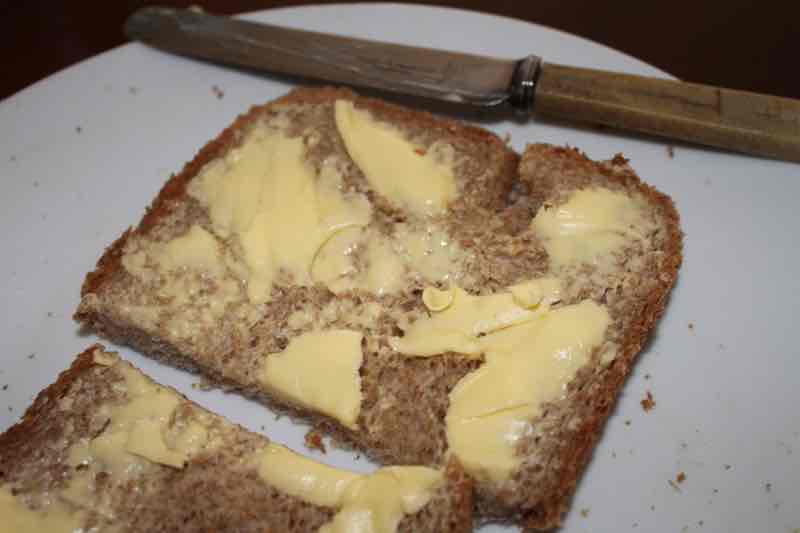
Extra fat and some protein like hummus or cheese help to lower the glycemic-index of the carbs even further.
Baking bread is a journey
Once you become fascinated by the difference in flavour and the nutrition of real and fake bread, you will likely find yourself at the beginning of a journey. There are pitfalls and disappointments but if you hang in you'll find it a source of wonder and deep-satisfaction.
The journey drew me on. Having started with baking fake bread with refined flour, I found it still gave me a deep bellyache; and stopped for several years. Then I heard about making the real loaf with sourdough; that was a huge step-forward and no longer did I suffer from the collywobbles, but I could still only stomach half a slice for supper, especially with soup.
The next step of this voyage of discovery was meeting a wheat-farmer. He talked me into buying a mill so that I could enjoy 100% flour with the full complement of ingredients in the kernel; it was just at that time that I discovered the virtues of whole grains versus those that are refined.
Then I had to learn how to preserve and store the wheat berries for a whole year so the weevils wouldn't get into it; yes, the first season was a disaster. This was when the price of my real bread really came down. The very best flour in the supermarket was not a quarter as good as my 100% wholemeal and cost four times as much.
Wellness
My wife and I are now in our mid-seventies and are in supremely good health; we take no medication whatsoever, never visit the pharmacy and have a checkup from our doctor every year or two.
I attribute it to four things.
- We try to eat ten or more coloured-foods every day.
- We take a probiotic called kefir several times a week.
- We bake real bread, of course, made with 100% flour using the sourdough-method.
- We are very active but really should walk more; we are trying. It's one of our failings.
Real and fake bread is a journey; you will never go back to the commercial-loaf. It tastes and is awful, and it's fattening; a major cause of type-2 diabetes.
Real bread helps to re-establish the intestinal microbes by supplying the fibre without which they cannot survive.
No question of it, salt and high blood pressure are connected; and commercial bread is one of the main culprits. Baking your own real loaf gives you control over the ingredients. Typically we use about half.
Kefir
I'm not quite sure how it happened but I started using kefir to supplement my sourdough-starter; perhaps just because I like to fiddle and experiment. I was astonished how it improved the crumb. Whether it is the dairy or the bacteria, I am really not sure.
I first became enamoured with making kefir after it largely cured a 15-year serious helicobacter infection with lots of pain; impervious to antibiotics, in just one week. Now it has helped delineate the distinction between real and fake bread.
Some of the kefir goes into the baking-tin to enhance our real bread and the rest into making a smoothie of one sort or another.
Real and fake bread
Real and fake bread asks hard questions about our favourite-food.
The real bread movement is taking off in the UK; folk are becoming sick and tired, literally of the commercial loaf. The inspiration behind it is a very experienced Scots baker by the name of Andrew Whitley.
They are behind the Sourdough September movement.
Weight loss research is unequivocal; learn about the distinction between real and fake bread if you want to live long in the land.
Diabetes
Interesting new medical research confirms what we already knew; type-2 diabetes can be brought completely into remission by lifestyle changes alone without the use of medication[6]. It's achieved by a return to a mainly plant-based diet, whole foods and short walks after starchy meals.
The issue of real and fake bread is central to this cure. The loaf baked with only whole grains can be enjoyed in moderation. One slice is enough; two and you'll feel overly stuffed.
What is the meaning of real bread?
So I hope by now you have some understanding of the meaning of real bread; the staff of life, not a toxic ultra-processed foodstuff that will make you fat, sick and give you a bellyache.
No chemicals are added, it's raised mainly with a sourdough starter that provides the natural bacteria and yeasts. They predigest the gluten and release the gas to make it rise.
But if you want protection against cardiovascular disease, breast and prostate cancer, then you will have to find a source of true wholegrain flour.
The natural anticoagulant, vitamin E is located in the germ and the lignans in the bran. Millers extract them and sell them at great profit as hominy chop to the pig farmers. We are left with the ultra-processed flour; and a lifetime of having to diet.
- Bernie's scientifically proven weight loss program; only real bread is allowed.
When browsing use right click and Open Link in New Tab, or you may get a bad gateway signal.
Steve and Marilyn Forte
I would like to pay a tribute to a friend and colleague, Steven Forte and his lovely wife Marilyn who unwittingly popped the first seed into my imagination. Forty years ago they had their own wheat-mill and introduced me to the difference between real and fake bread. Sadly I have completely lost contact with them; if anyone knows of their whereabouts, in Ohio I believe, I would love to hear about it.
That seed lay dormant for over ten years before it germinated; a wheat-farmer called Barry Sclanders watered it and today the distinction between real and fake bread has become profoundly important in our search for greater wellness.
This week half a ton of newly harvested wheat arrives as we strive to spread the good news, distinguishing real and fake bread at Reko Hilton; an organic farmers' market.
It's a hard choice I present to you, discussing real and fake bread. Give up the commercial loaf completely and learn to bake your own loaf. I see no other option if you love the taste of good food and want to avoid serious disease.
It comes as no surprise that in all five of the Blue Zones[5] of the world, where ten times as many folk reach a zestful dotage, that they eat only sourdough bread.
Newsletter
Our newsletter is entitled "create a cyan zone" at your home, preserving both yourself and Mother Earth for future generations; and the family too, of course. We promise not to spam you with daily emails promoting various products. You may get an occasional nudge to buy one of my books.
Here are the back issues.
- Lifestyle and ideal body weight
- What are ultra-processed foods?
- Investing in long-term health
- Diseases from plastic exposure
- Intensive lifestyle management for obesity has limited value
- A world largely devoid of Parkinson's Disease
- The impact of friendly bacteria in the tum on the prevention of cancer
- There's a hole in the bucket
- Everyone is talking about weight loss drugs
- Pull the sweet tooth
- If you suffer from heartburn plant a susu
- Refined maize meal and stunting
- Should agriculture and industry get priority for water and electricity?
- Nature is calling
- Mill your own flour
- Bake your own sourdough bread
- Microplastics from our water
- Alternative types of water storage
- Wear your clothes out
- Comfort foods
- Create a bee-friendly environment
- Go to bed slightly hungry
- Keep bees
- Blue zone folk are religious
- Reduce plastic waste
- Family is important
- What can go in compost?
- Grow broad beans for longevity
- Harvest and store sunshine
- Blue zone exercise
- Harvest and store your rainwater
- Create a cyan zone at your home
Did you find this page interesting? How about forwarding it to a friendly book or food junkie? Better still, a social media tick would help.
- Bernard Preston homepage
- Bread
- Real and Fake Bread
Address:
56 Groenekloof Rd,
Hilton, KZN
South Africa
Website:
https://www.bernard-preston.com